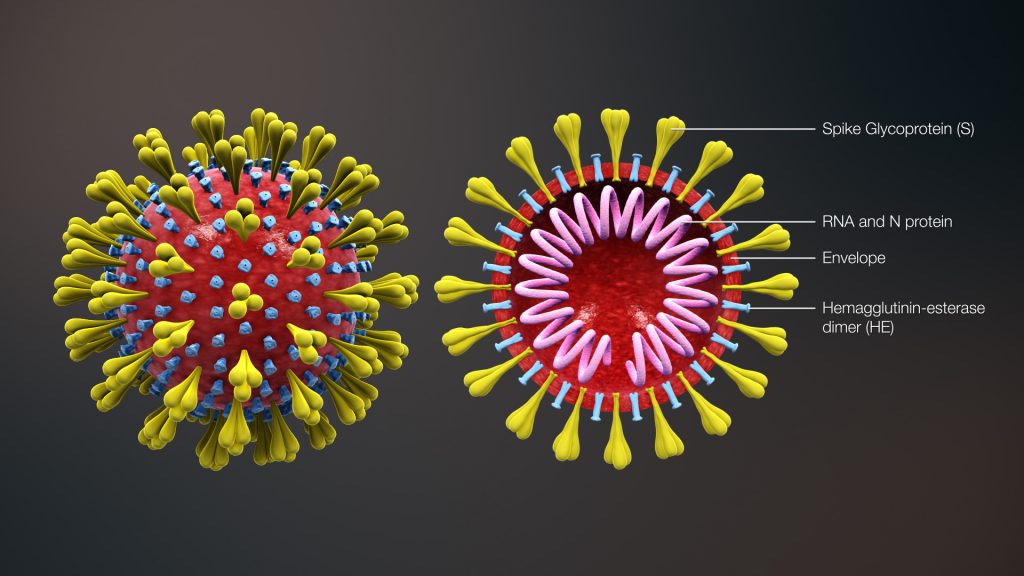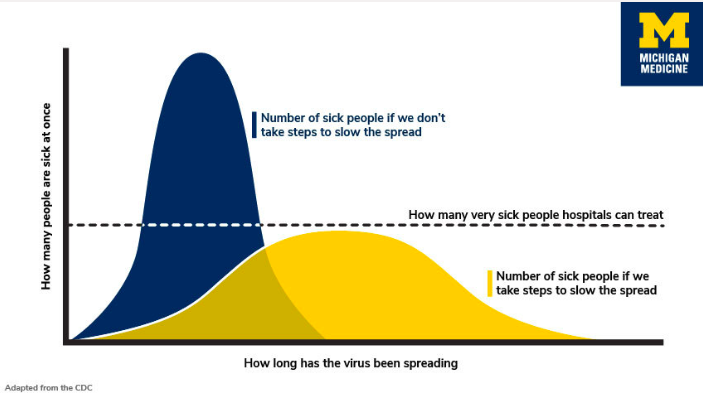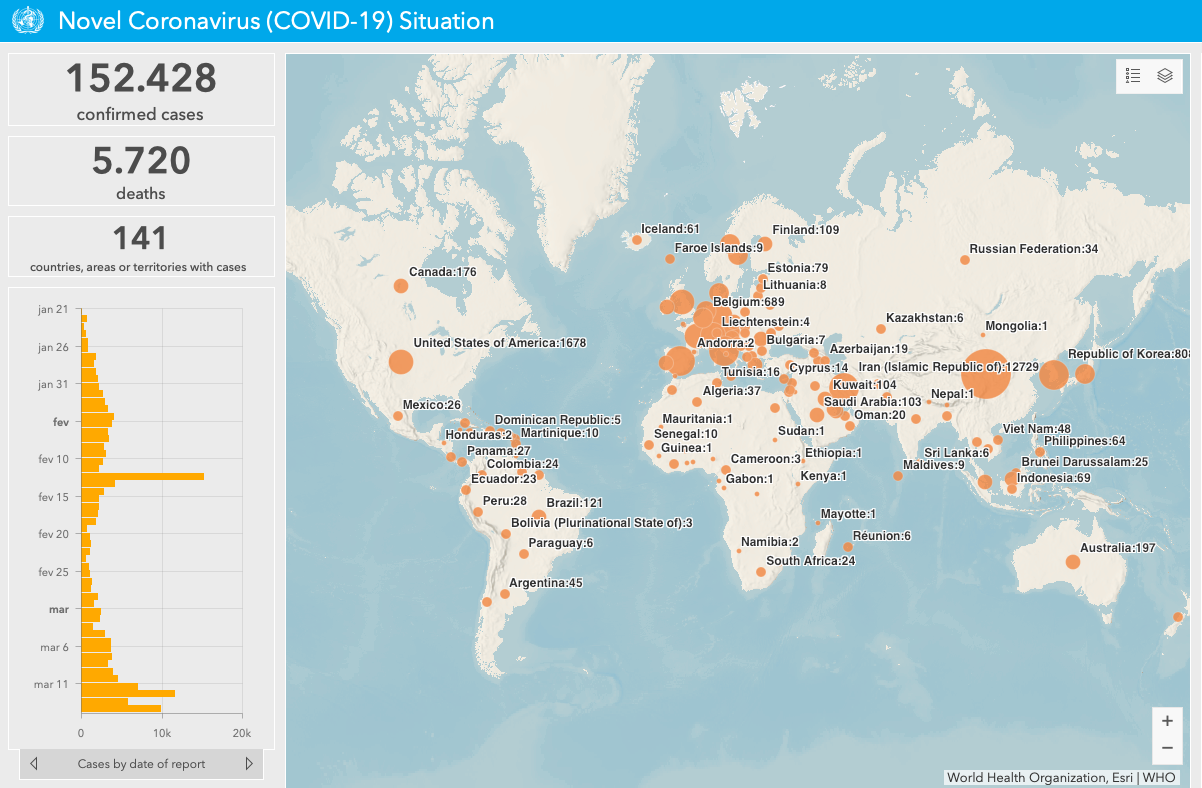Coronavirus, COVID-19 and cancer: what do we know so far? (English version)
Important definitions
– Outbreak: is the sudden increase in the number of cases of a specific disease in a specific region (for example, an outbreak of salmonellosis in a neighborhood);
– Epidemic: is an outbreak that happens in several regions (several neighborhoods, cities or states);
– Pandemic: when an epidemy affects several regions of the world, like the H1N1 infection in 2009 and the HIV infection, that are considered pandemics. Since February 2020, the coronavirus was defined as a pandemic disease, affecting people in all continents of the world;
– Endemic: is when a disease occurs in a constant frequency in some places (for example, yellow fever and tuberculosis in some countries).
What is a coronavirus?
Coronavirus are a family of virus which may infect humans and other animals. In humans, several coronaviruses cause respiratory infections like the Middle East respiratory syndrome (MERS) and the acute respiratory syndrome (SARS). Recently a new RNA betacoronavirus was identified as the causative agent of the Coronavirus Disease 2019 (COVID-19). In the medical literature COVID-19 may also be called severe acute respiratory syndrome coronavirus 2 and the virus may be called SARS-CoV-2.

COVID-19
The disease was first identified in China, in the province of Wuhan, in December 2019. It was manifested as an infection that disseminated very quickly. Despite not being as serious as other viral infections, it can be fatal in people with lung and cardiovascular diseases, those with reduced immunity and in the elderly. On January 30th, 2020, the World Health organization registered COVID-19 epidemic as an international public health emergency; as of March 4th, 2020, the infection was present in 77 countries. Most cases occurred in China or in people who returned from there.
As of February 25th, 2020, there were already 81,109 laboratory-documented cases and as of March 15th, 2020, there were 156,327 confirmed cases worldwide.
In January 2020, 1099 Chinese cases were described in a paper published in the New England Journal of Medicine. The statistics were as follows:
- Incubation period of the disease (when there are no symptoms yet, but the infected subject may transmits the virus): 4 days (ranging from 2 to 7 days); note: other studies have shown that the incubation period may last up to 14 days, which is the period that has been adopted by health authorities for isolation precautions;
- Median age: 47 years old (0.9% were below 15 years old);
- Male gender: 58%;
- Most common symptoms: fever (89%) ad cough (68%);
- Need for hospitalization and care in the intensive care unit: 5%;
- Need for mechanical ventilation (breathing with the help of medical devices): 2.3%;
- Median lenght of hospitalization: 12 days (ranging from 10 to 17 days);
- Deaths: 1.4%.
COVID-19 symptoms
The most common symptoms are fever, tiredness and dry cough; the symptoms are usually mild and start gradually. There may also occur body aches, nasal congestion, running nose, sore throat and diarrhea. In most cases, there is a spontaneous recovery of the infection, without the need for special treatment.
When there is fever, cough and difficulty of breathing, the patient should seek medical attention; the other cases should not be treated at the hospital but kept at home until recovery.
How COVID-19 spreads
- Contact from person to person through droplets from the nose (sneezing, running nose) and from the mouth (cough);
- Touching surfaces with droplets from infected people (and then placing tour hand over your mouth, eyes or nose).
It is recommended to stay at least 1 meter away from those who have the infection. There is still no evidence that the virus is transmitted through the air (without the droplets mentioned before), so there is no need for healthy people to wear masks.
Masks are only recommended for healthcare professionals who care for infected patients, for people taking care of these patients at home, for those who have cough and sneezes or for people who have laboratory-confirmed COVID-19 (in order to reduce transmission).
Who is at risk of having the most severe form of COVID-19?
People with systemic arterial hypertension, diabetes mellitus, heart disease, lung disease, cancer and other conditions that cause decreased immunity are at greater risk of developing the severe forms of the infection.
Risk in patients with cancer
Since the coronavirus pandemic is a recently known disease, we are still learning how to deal with it as new cases arise. The experience of countries like China (the epicenter of the infection) and Italy (the first European country to be severely affected by COVID-19) is an important tool to our understanding on how the disease occurs and what extent of damage it may cause.
Cancer patients in active treatment with medications that decrease immunity appear to be at increased risk of serious infections, although the number of cases in these patients is small.
In the published analysis of 1,099 cases of infection in China (Gwan et al), 10 patients had cancer (0.9%) and, of these, only 3 had the severe form of the disease.
In another analysis of 1,590 cases in 31 provinces in China (Liang et al.), 18 patients had cancer (1%):
- Lung cancer was the most frequent malignant diagnosis (5 patients; 28%);
- Of 16 cases with complete information, 4 (25%) had received chemotherapy or had undergone surgery in the last month before infection; the other 12 were on routine follow up;
- Compared to patients without cancer, those who had cancer were older (mean age 63 years x 48.7 years for non-cancer patients), had a higher frequency of smoking (22% x 7% in patients without cancer), had more shortness of breath (47% x 23% in patients without cancer) and more changes in chest tomography (94% x 71% in non-cancer patients)
- Cancer patients had a higher risk of serious illness (39% x 8% for patients without cancer).
Thus, people undergoing treatment for cancer should take extra care not to acquire the infection, avoiding contact with people with symptoms and with people who have traveled to epidemic areas and avoiding unnecessary travel and crowded places.
How to protect yourself from COVID-19
- First and most important measure: frequently HAND DESINFECTION with soap and water or alcohol-gel; this simple action will remove viruses from your hands;
- Keep at least 1 meter away from people who are coughing and sneezing since there may be viral particles in the droplets from the mouth and the nose of infected people;
- Avoid touching the mucous membranes of the eyes, nose and mouth (our hand can touch surfaces infected by the virus and take the viral particles to our mucous membranes; from there, the virus can enter our body);
- Follow adequate respiratory hygiene: when coughing and/or sneezing, cover your mouth and nose with your arm or forearm (and not with your hands); after using tissues to clean the secretions from your nose and mouth, immediately put them in the trash;
- Stay at home if you are not feeling well, even if the symptoms are mild, such as headache, low fever and running nose (so as not to infect other people in case you have the virus);
- Avoid travelling to places where there are cases of COVID-19;
- Seek information from reliable sources – do not spread or believe in fake news!

World Health Organization strategy to control the COVID-19 pandemic:
Strategy objectives:
– to decrease the transmission speed of COVID-19 until it is avoided, preventing outbreaks and delaying its spread;
– to provide adequate care for all patients, especially those with severe infection;
– to minimize the impact of the epidemic on health systems, social services and economic activity.
It is recommended that all countries be prepared to identify and respond to the emergence of cases of COVID-19 in different public health settings, with rapid implementation of the necessary measures to reduce the transmission and the public and social impact of the infection. COVID-19 transmission scenarios:The recommendations for each scenario can be accessed at the following link, and basically consist of hand washing, adequate respiratory hygiene (as explained before) and social distance, to reduce the risk of infection:
1. Countries without cases of infection;
2. Countries with 1 or more cases detected (sporadic cases);
3. Countries with groups of cases in certain locations with or without common exposure to the virus;
4. Countries with outbreaks of local transmission (community transmission)
Flattening the infection curve
A lot of people have been accessing graphics on the internet with titles like “flattening the curve” or similar. These charts explain why it is so important to institute measures to reduce the rate of transmission of the coronavirus infection.
The chart below, adapted from the United States Center for Disease Control and Prevention (CDC), extracted from the website https://healthblog.uofmhealth.org/wellness-prevention/flattening-curve-for-covid-19-what-does-it-mean-and-how-can-you-help, shows the scenarios where the infection spreads quickly (in blue), depleting the capacity of health services to treat patients, and when the virus spreads more slowly (yellow), giving enough time to allocate the necessary resources for the adequate treatment of cases, especially severe ones. The search for the yellow scenario aims to reduce the number of deaths by COVID-19 and should be sought by all citizens.

The Washington Post recently published very interesting graphics about what happens when you can flatten the transmission curve, which can be accessed at the following link: https://www.washingtonpost.com/graphics/2020/world/corona-simulator/
To access the number of confirmed cases of COVID-19 in real time, visit: https://experience.arcgis.com/experience/685d0ace521648f8a5beeeee1b9125cd
The figure below shows the situation on March 15th, 2020: 152,428 confirmed cases with 5,720 deaths, in 141 countries.

References
1.Guan W et al. Clinical Characteristics of Coronavirus Disease 2019 in China. N Engl J Med 2020; DOI: 10.1056/NEJMoa2002032.
2.Liang W et al. Cancer patients in SARS-CoV-2 infection: a nationwide analysis in China. Lancet Oncol 2020;21:335-7.
3.Chen N et al. Epidemiological and clinical characteristics of 99 cases of 2019 novel coronavirus pneumonia in Wuhan, China: a descriptive study. Lancet. 2020; (published online Jan 29.) https://doi.org/10.1016/S0140-6736(20)30211-7.
4.Wang C et al. A novel coronavirus outbreak of global health concern. Lancet. 2020; (published online Jan 24.) https://doi.org/10.1016/S0140-6736(20)30185-9.
5. Zhou P et al. A pneumonia outbreak associated with a new coronavirus of probable bat origin. Nature. 2020; (published online Feb 3.) DOI:10.1038/s41586-020-2012-7.
6. https://www.who.int/emergencies/diseases/novel-coronavirus-2019

Daniela Dornelles Rosa, MD PhD
Medical Oncologist
Porto Alegre, RS, Brazil

